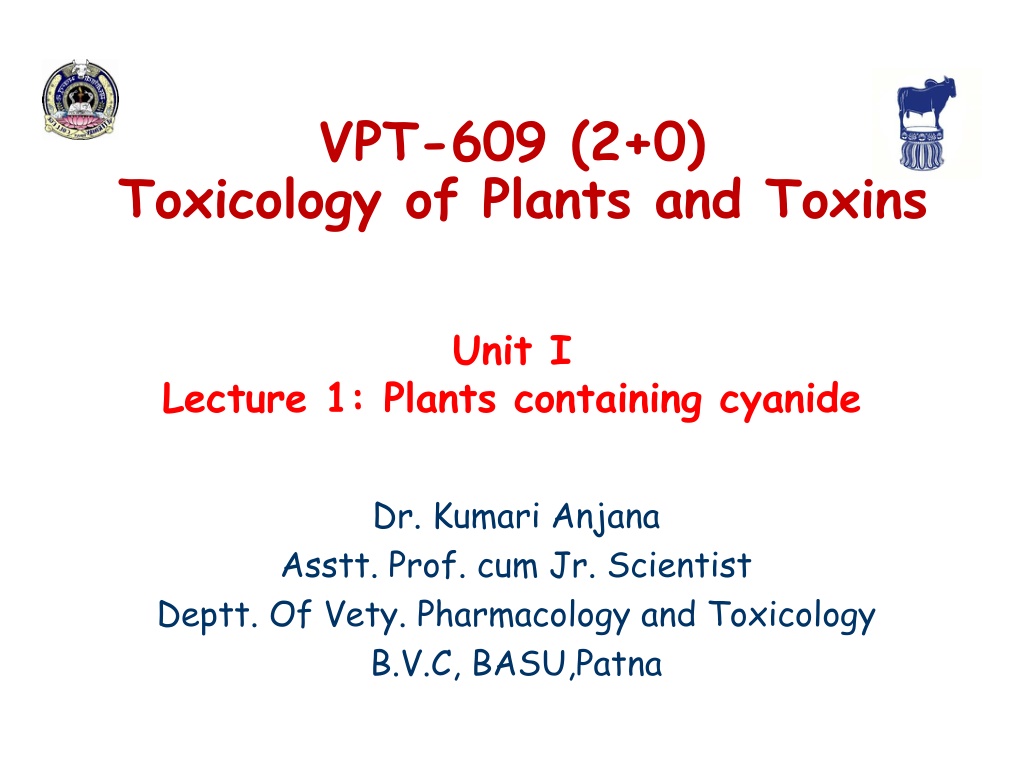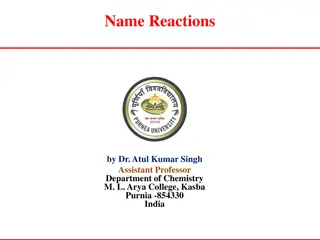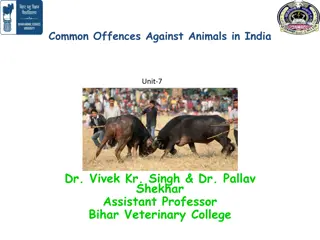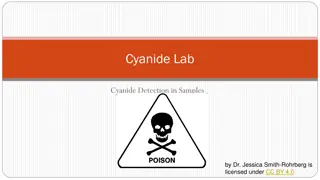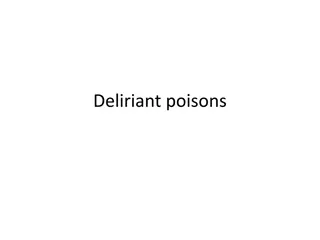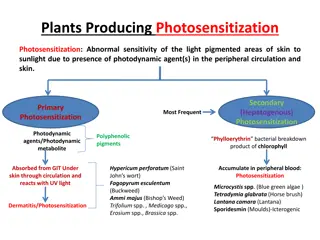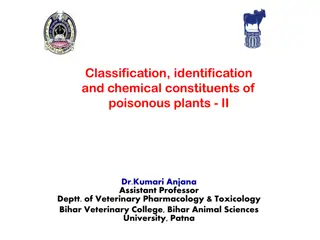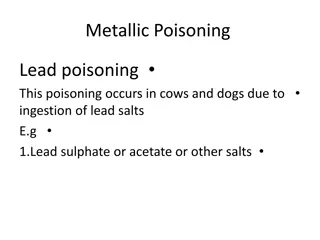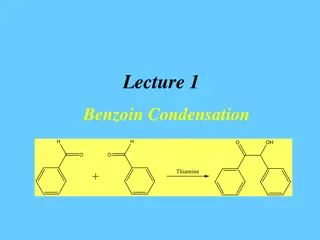Understanding Cyanogenic Plants and Cyanide Poisoning in Animals
This lecture introduces the toxicology of plants containing cyanide, focusing on factors affecting cyanide poisoning, cyanogenic plants, mechanisms of toxicosis, clinical signs, post-mortem lesions, diagnosis, treatment, and prevention. It discusses species variations in susceptibility, plant growth stages affecting toxicity, common cyanogenic plants like Sorghum vulgare and Bitter almonds, and the pharmacokinetics of cyanide in the body.
Uploaded on Oct 10, 2024 | 0 Views
Download Presentation

Please find below an Image/Link to download the presentation.
The content on the website is provided AS IS for your information and personal use only. It may not be sold, licensed, or shared on other websites without obtaining consent from the author. Download presentation by click this link. If you encounter any issues during the download, it is possible that the publisher has removed the file from their server.
E N D
Presentation Transcript
VPT-609 (2+0) Toxicology of Plants and Toxins Unit I Lecture 1: Plants containing cyanide Dr. Kumari Anjana Asstt. Prof. cum Jr. Scientist Deptt. Of Vety. Pharmacology and Toxicology B.V.C, BASU,Patna
Content of the chapter Introduction Factors affecting cyanide poisoning Cyanogenic plants (Glycoside) Mechanism of Toxicosis Clinical Signs Post mortem lesions Diagnosis Differential diagnosis Treatment and management Prevention
Cyanogenic plants Cyanogenic plants In plants CN in present in two forms: a free HCN a bound form (cyanogenic glycoside, CG). Bound form, cyanogenic glycoside Hydrolyzing enzymes of the luminal or intestinal micro flora or Hydrolyzing enzyme (B-glycosidase) present in the same plant or in other plants. Free HCN is liberated
Factors affecting cyanide poisoning Species variation Ruminants: most susceptible species. Sheep & goats: less susceptible. As compared to cattle or buffaloes (differences in the enzymes of fore stomachs). Pig and horse: relatively resistant to cyanogenic plant poisoning. Destruction of the hydrolyzing enzyme by gastric acidity (free HCN is released less).
Contd. Stage of growth of plants: Young, immature plants or rapidly growing plants especially after a period of drought are highly toxic (more HCN or the CG). Wilted/trampled or frost bitten plants are more toxic (ready liberation of free HCN). Rapidly growing parts of a plant contain more HCN than the older parts: Young/tender leaves or pods of Acacia leucophloea more toxic than the mature/old leaves or pods (more HON and CG). Nitrate fertilization or application of weedicides (2,4 - D) increases HCN in plants. Drying or ensiling of the plants lowers HCN content.
Cyanogenic plants (Glycoside) Sorghum vulgare and other sp. (Dhurrin), Linseed meal (Linamarin), Lotus sp. (Lotustralin or lotusin), Bitter almonds: (amygdalin)
Pharmacokinetics HCN is rapidly absorbed from GIT or from lungs through inhalation. In liver it is rapidly detoxified to thiocyanate by rhodanese enzyme, which is excreted through urine. Some HCN is also excreted through exhaled air giving a characteristic bitter almonds smell to the expired air. However, if excess HCN is liberated it is absorbed resulting in toxicity.
Mechanism of Toxicosis Death in cyanide toxicity is cytotoxic anoxia. The CN ion has great affinity to Ferric ion of Cytochrome Oxidase, an important enzyme in the respiratory chain responsible for utilization of oxygen for cellular oxidative reactions and energy production. Therefore, the cyanide ion by forming a complex inactivates the enzyme (cyan-cytochrome oxidase). Oxygen is not exchanged for cellular metabolic reactions and it is retained in the blood (bright red color).
Contd. Though oxygen is there it is not being used, thus resembling a condition lack of oxygen anoxia. Therefore, the cells die i,e cytotoxicity. Cell death is due to cytotoxic anoxia. A cyanide concentration of only 33 M can completely blocks electron transfer through mitochondrial electron chain, thus preventing oxygen utilization.
Clinical Signs In most of the cases the poisoning has been of acute in nature. If large quantities of the cyanogenic plant are ingested, the animals die within 30 min of ingestion. If death is prolonged the animals show: anxiety, restlessness, bright red mucosae (in the beginning), staggering gait, muscular tremors, weak and rapid pulse, recumbency, bloat, respiratory distress, opisthotonus, terminal convulsions, cyanotic mucosa (in terminal stages) and death (resp. failure).
Post mortem lesions Congestion and or haemorrhages in internal organ. Blood remains unclotted and bright red in colour. When the stomach /rumen are opened a smell of bitter almonds is felt. Laboratory analysis of stomach or ruminal contents, liver and muscle reveals presence of HCN.
Diagnosis History of sudden death following grazing in the vicinity or near the suspected plants. Acute anoxic syndrome. Bright red coloured blood and mucus membranes. Post mortem lesion. Detection of HCN in the suspected plan materials or ruminal / stomach contents by picrate paper test.
Differential diagnosis Carbon monoxide: InCO poisoning, colour of blood is bright red but death is not so acute. Hydrogen sulphide: It causes rapid death by inhibition of cytochrome oxidase, but blood and tissues are dark brown in colour and smell of H2S comes from tissues. Nitrate and Nitrite: Nitrate and Nitrite causes rapid death but colour of blood is brown red. Urea: Urea causesrapid death but main signs are colic, nervous and behavioural changes. Rumen gives off odour of ammonia.
Treatment and management Sodium nitrite: It is used as an antidote to cyanide, often in conjugation thiosulphate. with sodium Sodium nitrite converts some haemoglobin (Fe++) to methaemoglobin (Fe+++) by process of oxidation. Methaemoglobin in turn reacts with lethal cyanide ion of cyan-cytochrome oxidase to produce cyan- methaemoglobin. CN _ + Cyt Cn-Cyt Hb + NO2- MetHb CN-Cyt + MetHb CN- MetHb + Cyt
This cytochrome oxidase enzyme. process reactivates the inactivated The cyan-methaemoglobin in the presence of enzyme rhodanase takes sulphur from the donor sodium thiosulphate (Na2SO3) and forms sodium thiocyanate (NaSCN) which is non toxic and eliminated through urine. Haemoglobin (Fe++) is released during the process. Note : Sodium nitrite is a toxic substance due to its potential to produce methaemoglobinaemia, so its dose should be carefully regulated.
Sodium thiosulphate: It is often administered after systemic administration of sodium nitrite, but alone also is an effective antidote to cyanide poisoning. Sodium thisulphate hastens detoxification of cyanide by providing an exogenous source of sulphur to the enzyme rhodanese. The cyanide in presence of enzyme rhodanese takes sulphur from the donor thisulphate and forms Sodium thiosulphate, which is relatively non toxic and is eliminated via the urine.
Mechanism of action of sodium nitrite in cyanide poisoning Cyanide + Cytochrome oxidase Sodium nitrite + haemoglobin Cyan- cytochrome oxidase Methaemoglobin Reactivated cytochrome oxidase Cyan-methaemoglobin Sodium thiosulphate + Rhodanese Sodium thiocyanate + Sodium sulphite Haemoglobin
Cattle and Sheep : Sodium nitrite @ 20 mg/kg, slow IV as 1% solution followed by sodium thiosulphate ( 500 mg/kg, slow IV as 25 % solution). Dogs and cats : Sodium nitrite 25 mg/kg, slow IV as 1% solution followed by sodium thiosulphate (1.25 g/kg, IV as 25 % solution). Horses: Sodium nitrite 16 mg/kg, slow IV as 1% solution followed by sodium thiosulphate (30 - 40 mg/kg, IV slow as 20 % solution).
Prevention Chop or ensile plants high in hydrocyanic acid to reduce HCN level. Dry and cure the hay before baling. Well cured hay is rarely hazardous since HCN content declines during the curing process. Thoroughly boil the linseed gruel to remove any free hydrocyanic acid. Avoid high levels of soil nitrogen.
